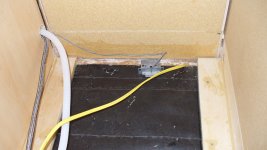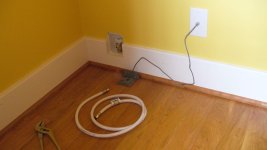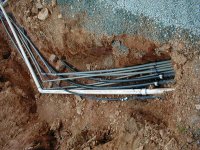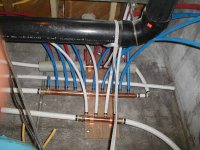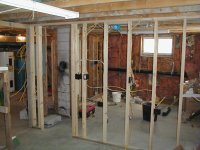eepete
Platinum Member
Ok, now for the exotic stuff 
Probably highest rated item on the spousal approval scale is the buried vehicle sensor for the driveway. It's a $250 thing that you burry beside the driveway that takes 12V DC and gives you contact closure when some big piece of metal moves within 10 feet of it. You connect it to your system and it makes a noise or says something when someone comes down the driveway.
I have two placed at two places on the driveway so I can tell if someone is coming or going. This can also be used to turn on outside lights when a car comes down the driveway. Stops most people dead in their tracks, and having the lights on is great for the home owner too.
Another fun one is the water detector. Same "12V, contact closure" device. 1st pix is a detector in the hole that the dish washer will go in. If it leaks, an automation system can do something about it. The 2nd pix is the same idea behind the refrigerator. I also have RJ-45 jacks to cat5e by all toilets, the washing machines, and hot water heaters (which are in pans with drains too).
cat5e to the kitchen ceiling and garage ceiling. You can put in heat detectors for fire alarm stuff. Cat5e for control panels for an alarm system in the master bedroom and by the garage door.
How is your cell phone service in the house? Low-E glass eats radio frequency signals. The open cell foam insulation (isocyonate?) also eats RF. The little $300 cell phone boosters need a 50 to 60' run of coax to the outside, preferably higher up in the air, to do their thing. A run to the attic would let you put an antenna up there and put the extender down in the house in the bad area. 50' run limit is not a problem if you plan it.
Lighting control is fun. Being overly frugal I cheap out and used relays. That way, a control system can turn on a light independent of the switch, but the switch still works no matter what state the controller or alarm system (be it broken or not yet installed). You can either put a relay across the contacts of a single switch or... what I did was from the switch that has the run to the light, I ran a 14-3 to a box in a closet I would have access to after everything was done and sealed up. In the 14-3, black was hot, white (with a piece of red tape on it so it won't be confused with neutral) was what used to go to the bulb, and red is the wire to the bulb. You wire nut the white and red, wire nut cap off the black, and everything works as it should. You also run a 18 gauge pair from the box to the central point. Then later you can put in a relay that can turn on the light even if it's a 2 way or N way light.
There are also after market ways to do lighting, but it cost about $130 per switch to change it out, and another $90 for the control box, and your control or alarm system has to know how to talk to the box.
Now think about the control system using the motion detectors, door switches, and driveway detector to turn on lights.
Run a cat5e outside to the north side of the house, in a protected area if possible. Then you can put in an outside temperature and humidity sensor. Enclosed is a plot from my logging system.
My septic system alarm circuit board had a space for relay. I added the relay and when I ran the power conduit to the control for the tank, I added a smaller low voltage conduit so I get contact closure if the system has any problems.
I have small current sensors that I can put in the breaker panel box on various circuits. These can be used for monitoring energy use, but also fun stuff like this: The flat cook top has a sensor. If it comes on between 11:00 PM and 6:00 AM, I hear about it. That means a cat has somehow unlocked it and turn on the stove. Have on on the oven. If it's on for more than 3 hours, I hear about it (in case someone forgot to turn it off). How about a sensor on the basement light circuit so if they are left on you can tell? So a conduit (1.5" or so) between the breaker box area and your low voltage area lets you add these as your imagination goes nuts.
I bought a water meter and put it in at the house. Have a hall effect sensor that I put on top of it where the actual meter used to be. Now I can record my water use. I can also tell if someone left the hose running.
The automation system can tell if the phone is off the hook. If it's too long, I hear about it. Caller ID is extracted from a ringing phone and sent to my cell phone as a text message. Calls are announced via the speakers in the house. So all phone stuff should be in the same low voltage wiring area.
I have antenas in the attic and an 18 gauge wire for power for amplifiers. Coax brings the antenna signal down. I have security cameras that go into modulators. I then mix those back into the cable for "off air" and it goes to TV sets so you can see the security cameras from any TV. If you do this, you'll want 3 coaxes to each possible TV site- two for satellite, one for off air and surveillance.
For all surveillance cameras, I have a coax, an 18 gauge for power, and a cat5e because sometime soon the old NTSC video cameras will all be Ethernet hi definition cameras.
On a 2nd floor window, I have a zoom camera that is focused down the driveway. We have a small 19" TV in the TV room that shows the main outside cameras. When a car comes, you can just look at the cameras and see what/who it is.
Temperature sensor in the attic. When attics catch fire, by the time the occupants find out it's too late. House also has a sprinkler system, that's a whole different topic not wiring related (except for the flow sensor...).
Not low voltage, but, I have a single 30 amp UPS in the basement in the low voltage room. It runs into a small 6 circuit panel. Certain outlet and cat5e boxes in the offices, kid computer area, box above the 'fridge, TV room, and master bedrooms feed off of the UPS. So now instead of 3-4 little ones there is one big one. The feed to the bedrooms is for grins now (no disruption of TV if power goes out while waiting for the generator) and down the road it might keep some silly machine that is keeping me alive going when the power goes out.
There are a few more really far out there things that are not available yet, but this should get you thinking.
Next: Earth to Pete, bring it back home for the rest of us :laughing:
Probably highest rated item on the spousal approval scale is the buried vehicle sensor for the driveway. It's a $250 thing that you burry beside the driveway that takes 12V DC and gives you contact closure when some big piece of metal moves within 10 feet of it. You connect it to your system and it makes a noise or says something when someone comes down the driveway.
I have two placed at two places on the driveway so I can tell if someone is coming or going. This can also be used to turn on outside lights when a car comes down the driveway. Stops most people dead in their tracks, and having the lights on is great for the home owner too.
Another fun one is the water detector. Same "12V, contact closure" device. 1st pix is a detector in the hole that the dish washer will go in. If it leaks, an automation system can do something about it. The 2nd pix is the same idea behind the refrigerator. I also have RJ-45 jacks to cat5e by all toilets, the washing machines, and hot water heaters (which are in pans with drains too).
cat5e to the kitchen ceiling and garage ceiling. You can put in heat detectors for fire alarm stuff. Cat5e for control panels for an alarm system in the master bedroom and by the garage door.
How is your cell phone service in the house? Low-E glass eats radio frequency signals. The open cell foam insulation (isocyonate?) also eats RF. The little $300 cell phone boosters need a 50 to 60' run of coax to the outside, preferably higher up in the air, to do their thing. A run to the attic would let you put an antenna up there and put the extender down in the house in the bad area. 50' run limit is not a problem if you plan it.
Lighting control is fun. Being overly frugal I cheap out and used relays. That way, a control system can turn on a light independent of the switch, but the switch still works no matter what state the controller or alarm system (be it broken or not yet installed). You can either put a relay across the contacts of a single switch or... what I did was from the switch that has the run to the light, I ran a 14-3 to a box in a closet I would have access to after everything was done and sealed up. In the 14-3, black was hot, white (with a piece of red tape on it so it won't be confused with neutral) was what used to go to the bulb, and red is the wire to the bulb. You wire nut the white and red, wire nut cap off the black, and everything works as it should. You also run a 18 gauge pair from the box to the central point. Then later you can put in a relay that can turn on the light even if it's a 2 way or N way light.
There are also after market ways to do lighting, but it cost about $130 per switch to change it out, and another $90 for the control box, and your control or alarm system has to know how to talk to the box.
Now think about the control system using the motion detectors, door switches, and driveway detector to turn on lights.
Run a cat5e outside to the north side of the house, in a protected area if possible. Then you can put in an outside temperature and humidity sensor. Enclosed is a plot from my logging system.
My septic system alarm circuit board had a space for relay. I added the relay and when I ran the power conduit to the control for the tank, I added a smaller low voltage conduit so I get contact closure if the system has any problems.
I have small current sensors that I can put in the breaker panel box on various circuits. These can be used for monitoring energy use, but also fun stuff like this: The flat cook top has a sensor. If it comes on between 11:00 PM and 6:00 AM, I hear about it. That means a cat has somehow unlocked it and turn on the stove. Have on on the oven. If it's on for more than 3 hours, I hear about it (in case someone forgot to turn it off). How about a sensor on the basement light circuit so if they are left on you can tell? So a conduit (1.5" or so) between the breaker box area and your low voltage area lets you add these as your imagination goes nuts.
I bought a water meter and put it in at the house. Have a hall effect sensor that I put on top of it where the actual meter used to be. Now I can record my water use. I can also tell if someone left the hose running.
The automation system can tell if the phone is off the hook. If it's too long, I hear about it. Caller ID is extracted from a ringing phone and sent to my cell phone as a text message. Calls are announced via the speakers in the house. So all phone stuff should be in the same low voltage wiring area.
I have antenas in the attic and an 18 gauge wire for power for amplifiers. Coax brings the antenna signal down. I have security cameras that go into modulators. I then mix those back into the cable for "off air" and it goes to TV sets so you can see the security cameras from any TV. If you do this, you'll want 3 coaxes to each possible TV site- two for satellite, one for off air and surveillance.
For all surveillance cameras, I have a coax, an 18 gauge for power, and a cat5e because sometime soon the old NTSC video cameras will all be Ethernet hi definition cameras.
On a 2nd floor window, I have a zoom camera that is focused down the driveway. We have a small 19" TV in the TV room that shows the main outside cameras. When a car comes, you can just look at the cameras and see what/who it is.
Temperature sensor in the attic. When attics catch fire, by the time the occupants find out it's too late. House also has a sprinkler system, that's a whole different topic not wiring related (except for the flow sensor...).
Not low voltage, but, I have a single 30 amp UPS in the basement in the low voltage room. It runs into a small 6 circuit panel. Certain outlet and cat5e boxes in the offices, kid computer area, box above the 'fridge, TV room, and master bedrooms feed off of the UPS. So now instead of 3-4 little ones there is one big one. The feed to the bedrooms is for grins now (no disruption of TV if power goes out while waiting for the generator) and down the road it might keep some silly machine that is keeping me alive going when the power goes out.
There are a few more really far out there things that are not available yet, but this should get you thinking.
Next: Earth to Pete, bring it back home for the rest of us :laughing:
Attachments
Last edited:
